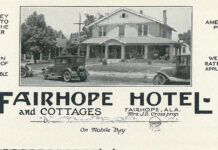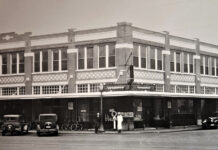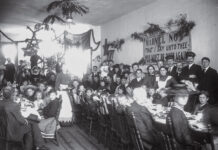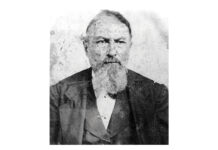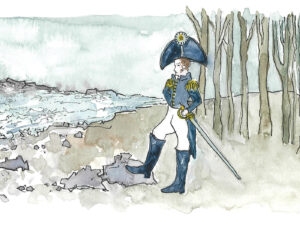
Major Uriah Blue, a prominent serviceman in the United States Army, was one of the most significant figures in the Creek War, the early Seminole Wars and the War of 1812. Like Forrest Gump, he seemed to be at every pivotal moment during that era. Despite his remarkable involvement, he remains virtually unknown to inexpert citizens and historians alike.
Around the turn of the 19th century, a 20-something Blue joined the regular Army as a lieutenant when war with France seemed likely. As was common of unmarried young military officers, he drifted in and out of military service until about 1812 when he was stationed at Fort Stoddert in present-day Mount Vernon, Alabama.
It’s not until the massacre at Fort Mims that we hear about Uriah Blue in these parts.
Fort Mims Massacre
General Ferdinand Leigh had withdrawn most of his soldiers from Fort Stoddert around the time Blue assumed his position there, leaving only 40 sick and injured soldiers. He placed Blue in command of a unit of Regulars reinforced by 100 troops of the 7th Infantry Regiments in early September. While he adjusted to his new appointment, Blue had the support of Mississippi Territory Militia Captain and Brevet Brigade Major Joseph Pulaski Kennedy, an Ivy-league educated lawyer who led Alabama in the abortive West Florida Revolution of 1810.
When news of the Fort Mims Massacre broke, Claiborne waited for Kennedy to conduct an ersatz funeral for the deceased before finally sending Blue, Kennedy and 10 men to the fort by flatboat to examine the magnitude of the bloodshed and properly inter the departed. They arrived to discover a horrifying sight of hundreds of dead, mangled, burned and scalped rotting bodies. A report on the destruction was filed the following day, which remained unpublished and largely unseen until 2006.
More than three weeks after the initial discovery, Blue and Kennedy returned to Fort Mims with Dr. Thomas G. Holmes and 300 of their best men to bury the dead. Holmes was interviewed by one of Alabama’s first historians, Albert James Pickett, who preserved the doctor’s gruesome notes on the condition of the bodies and the funerals held in their honor. Holmes reported that they counted 247 slaughtered men, women and children, including whites, slaves and allies from nearby Creek Red Stick tribes.
Just six months later, after the American victory at the Battle of Horseshoe Bend and subsequent signing of the Treaty of Fort Jackson which gave U.S. lands to “friendly indians”, the remaining Creek Red Stick holdouts retreated south and then east. Most congregated in what is now the western Florida panhandle, which Spain then owned but was struggling to maintain. Napoleon had conquered the now-bankrupt country and placed his brother on the throne. In pursuit of the Red Sticks, General Andrew Jackson marched part of his army down to the Mobile Bay area, and sent another part down the Alabama River via flatboat. They encamped with the few supplies they had at Fort Deposit.
Blue and his adjutant, Kennedy, had established the base of the 39th Regiment of Regulars at Fort Montgomery, a largely empty supply dump and gathering site near Fort Mims in the Tensaw Lake area. Their forces — regulars and militia as well as some Chickasaws and Choctaws — moved southeast from there into Florida.
Nine hundred Red Sticks took refuge in Pensacola, an area with which they were familiar due to a sustained trading relationship with John Forbes & Co. A sign reading “Muscogee Wharf” marks the site of the camp today. The Indians needed food, supplies and protection, and they thought they’d find refuge in Spanish territory. The Pensacola Spaniards, for their part, were generally overwhelmed by a lack of Spanish support.
While the War of 1812 officially began when the US declared war on Great Britain on June 18, 1812, a subsidiary conflict Alabamians call “The Creek Indian War” was incited by the Massacre of Fort Mims on August 30, 1813.
Creek Indians were named by the British in Savannah, who identified a Muskogean tribe living on a particular creek. At the end of the Creek Indian War in Alabama, those Red Stick Indians who did not want to surrender fled South and East into Florida where they came to be called Seminoles, from the Spanish word meaning
“fleeing”.
Battle of New Orleans
In mid-September of 1814, the British attacked Fort Bowyer, the predecessor of Fort Morgan on the spit of the southeastern side of Mobile Bay. In this first attack, the British used four ships and a diversionary land force of Royal Marines. Their biggest ship, the HMS Hermes, caught fire and exploded when it ran aground at musket range and was riddled by the fort’s guns. The British moved on to New Orleans after the American victory. Meanwhile in Apalachicola and Pensacola, the British relieved the Spanish of some pressure by equipping Red Sticks and slaves to fight American troops.
Jackson was in command of a “mop-up operation,” a commonly used military phrase of the time marking a conquest in capturing or killing remaining enemy troops. He marched his army into Florida where British forces, Creeks and a battalion of escaped slaves were billeted. Jackson, otherwise known by the moniker “Old Hickory” and never one to stand on arcane legal principles like the neutrality of Spain, captured Pensacola on November 7, 1814. The British fell back to their secondary base at Prospect Point in Apalachicola.
Early that winter, Jackson learned that the British were assembling ships and soldiers in Jamaica for an attack on the Gulf Coast, likely targeting New Orleans. He split his army and marched the main troops through Mobile to Louisiana for the Battle of New Orleans campaign, in which we all know Jackson won (if only because those of us with a little age can still sing Johnny Horton’s song, The Battle of New Orleans).
The American victory in the Crescent City galvanized Jackson’s resolve to conquer the Red Sticks in the Florida panhandle, and he placed Blue at the helm of the operation.
Return to Fort Montgomery
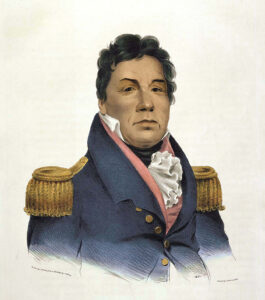
Chief Pushmataaha, a highly-regarded Chocktaw chief known for his diplomacy and military cunning, as depicted in History of the Indian Tribes of North America. Image courtesy Wikicommons
Just after the massacre at Fort Mims, a call for militia from Tennessee and Kentucky brought Jackson a slew of sharpshooting militiamen to the Mobile area, including Major William Russell’s battalion of Tennessee Mounted Gunmen and a large faction of John Coffee’s brigade. They were augmented by Blue’s large force of mounted men and by Chickasaw and Choctaw warriors, including Tishomingo, James Brown, Coahoma, Tuscumby and Chief Pushmataha. Davy Crockett himself later joined the outfit and enlisted as a scout with a Tennessee company of mounted riflemen.
The forces returned to Fort Montgomery to restock their supplies for their mission, but they were dismayed to find that the supplies at the hold were delayed and scarce. Blue and his troops then departed Fort Montgomery, carrying only 20 days’ worth of supplies. They crossed many river swamps on foot during the coldest, rainiest season of the year because their horses and wagons couldn’t traverse the muddy terrain. Crockett later wrote that he and the men “just put in like so many spaniels, and waded on, sometimes up to our armpits.” They finally reached Turvin’s Bluff on the Escambia River north of Pensacola, where they managed to secure a boat and supplies. Soon after their arrival, the Americans got into a skirmish with a nearby Red Stick encampment. They killed 20 warriors and captured 150 of their family members, who were then marched back across the Escambia River with a detachment to Fort Montgomery.
Word broke that some Indians were stationed at Garcon Point. Blue sent a detachment to Garcon Point to capture an escaped slave who was accused of giving the Red Sticks intelligence about the defenses of Fort Mims. Three captains sent to track other enemy tribes who had escaped by canoe to Pensacola followed a trail to the tanning house of a man named John Innerarity. Though Innerarity, owner of the aforementioned John Forbes & Co., traveled frequently with the Creeks, he denied having knowledge about the Indians. The captains broke down the man’s door and found and caught 10 Indians and some runaway slaves. The captives were taken back to Blue and Kennedy at Garcon Point, who sent them with yet another detachment to Fort Montgomery.
A week later, Blue and his men regrouped near present-day Floridatown after learning of enemy tribes near the Choctawhatchee River. The Americans and Chickasaws found and killed 30 Creeks near the Yellow River, including their chief known as “the Alabama King.” Another 75 were captured and sent with a detachment back to Fort Montgomery.
Short Supplies
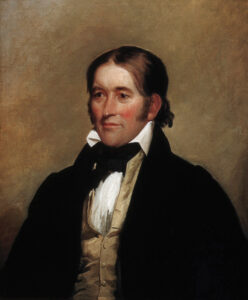
Davy Crockett was a politician, frontiersman and soldier who was widely-known as “King of the Wild Frontier.”
Image courtesy Wikicommons
The Treaty of Ghent was signed on Christmas Eve in 1814, ending the War of 1812. But nobody around here knew about that until later, so the war carried on locally.
By Christmas, Blue and his men were freezing, exhausted and mostly out of food. Crockett wrote, “I remember well that I had not tasted bread but twice in 19 days. I had bought a pretty good supply of coffee from the boat that had reached us from Pensacola, on the Scamby, and on that we chiefly subsisted.”
But that Christmas Day, Blue heard that scouts located the main Red Stick camp at present-day Vernon on Holmes Creek. They marched frozen and hungry all night, but found the place deserted upon an attempted attack at dawn. With promised food and reinforcements from the Georgia militia and allied Indians having never arrived, he could not proceed to attack the British and their native allies in Apalachicola.
Blue split his forces. Major Russell and 500 starving Tennessee Volunteers — including Davy Crockett — were sent up the Tallapoosa to Fort Jackson. Crockett later wrote, “We all began to get nearly ready to give up the ghost, and lie down and die. I hunted every day, and would kill every hawk, bird and squirrel that I could find. Others did the same; and it was a rule with us, that when we stop’d at night, the hunters would throw all they killed in a pile, and then we would make a general division among all the men.”
The other half of Blue’s men were led back to Fort Montgomery. Blue wrote to Jackson, then in the midst of the New Orleans campaign, that his outfit was “without provisions of any kind; the horses are unable to go any farther.” They narrowly made it back to the fort on January 9, 1815, officially ending their operation.
Blue’s respite was short-lived. General James Winchester summoned the exhausted major and the 100 Creeks he managed to recruit to Mobile to assist in defending the city from the British. Their intelligence informed them of Jackson’s victory in New Orleans and a second British attack on Fort Bowyer. Winchester sent Blue, Kennedy and about 1000 of his own troops to Mobile to relieve the siege.
End of Service
Later in life, when Kennedy was accused of “losing Mobile Point” back in 1815, he explained that Blue was in command of the 39th regiment and that he was his Adjutant and in command of Indians.
Blue and Kennedy “repeatedly applied to General Winchester for a command of men in addition to the Indians to be sent to the relief of Lieutenant Colonel Lawrence” at Fort Bowyer until their request “was after some time, complied with.” The force of approximately 1,100 men was sent to “the vicinity of Fort Bowyer after it had been surrendered to the enemy.” Blue halted just east of the Fort, but he sent Kennedy ahead in his stead. Having earlier surveyed the coast, Kennedy was “of opinion that we could cross the Bayou which empties into Navy Cove, which is fordable, supposing that the enemy had not occupied that position.” After discovering that the British had erected a battery of cannon at the Bayou, he recommended leaving a small group to watch the British, while occupying a small neck of land between the Bayou and the Gulf of Mexico. The maneuver proved to have merit. Though an attempt to capture a British picket to get intelligence was unsuccessful, they managed to capture a British barge the following day. Learning from their conquest that Fort Bowyer had fallen and anticipating a British attack on Mobile, the outfit returned to the Port City.
Instead of an attack, the HMS Brazen arrived on February 13 with the news that the Treaty of Ghent had been signed on Christmas Eve, ending the war. The Brits left Alabama and took their fight out to the battlefields of Waterloo.
The war over, Blue wrote Jackson asking for a furlough, saying that in his 12 years of service he had “never had a furlough for two days at a time in my life.” He was honorably discharged on June 15, 1815. He returned to service in the 8th Infantry after a six-month sabbatical, but the siren call of retirement was too enticing to resist. He laid down his arms and returned to civilian life one year later. He lived out his days on his farm on the Eastern Shore.
Once lost to the annals of history, Major Uriah Blue’s military exploits proved pivotal in shaping the trajectory of the War of 1812. Let us never again forget his strategic acumen and unwavering dedication on the battlefield that altered the course of history and left an indelible mark on the conflict’s outcome.
The “final” victory of General Jackson over the Creek Red Sticks was at Horseshoe Bend, on the Tallapoosa River south of present Lake Martin. The Red Stick Creek chief William Weatherford [never in his life called Red Eagle] soon after that battle surrendered to Jackson’s Army at a rough fort called Fort Jackson, and the Creeks and Jackson concluded a treaty called “The Treaty of Fort Jackson,” which also gave U.S. lands to the “friendly Creeks”.
David Bagwell is a retired attorney and amateur historian living on the Eastern Shore.

